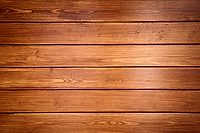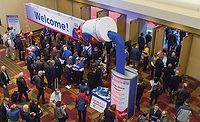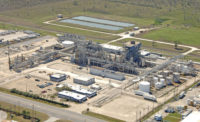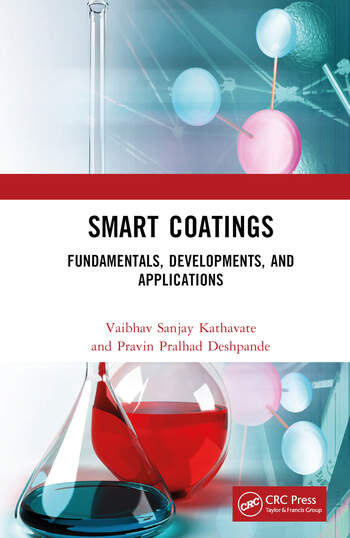A Look at Dow’s Paint Farm and Technology Center

An aerial view of Dow’s exposure site in Spring House, PA.

Dow’s Technology Center in Collegeville, PA.
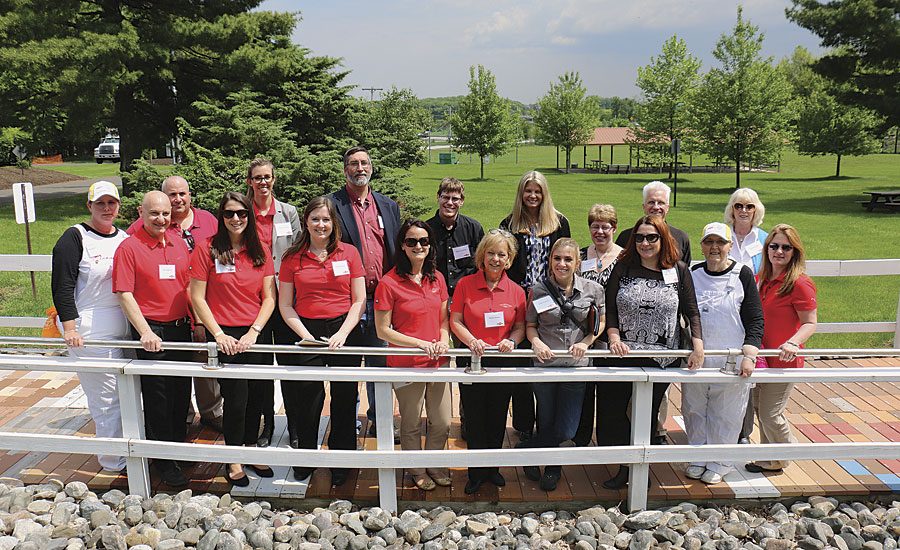
Members of the Dow team and the media who participated in the event.

A researcher at Dow's Collegeville Technology Center.
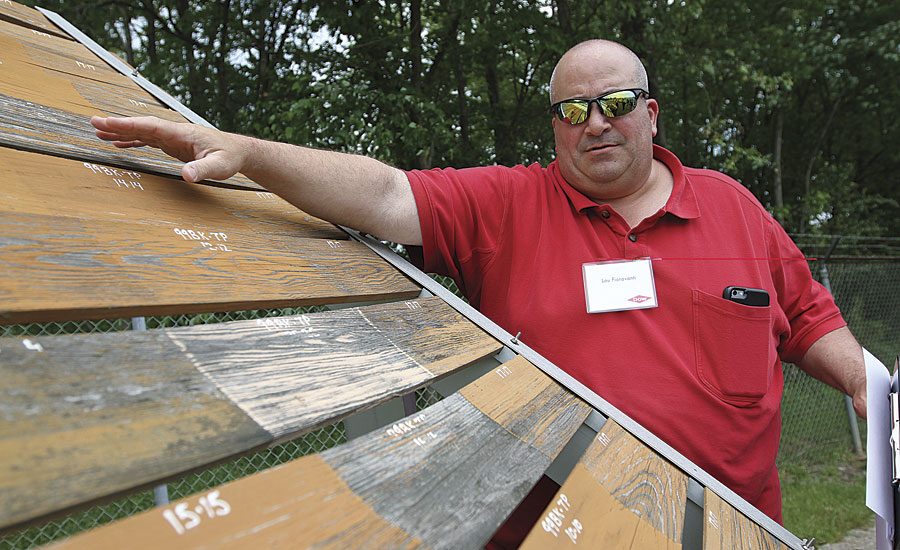
Lou Fioravanti shows how wood panels with different paints have stood up to years of weathering.
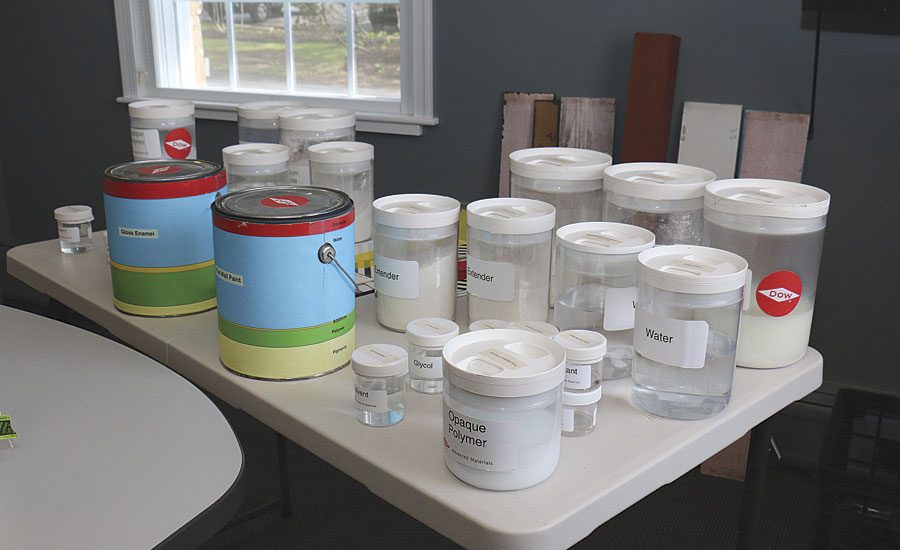
John Calderaio’s demonstration of what goes into a regular can of paint, versus a higher-quality paint.






Dow recently hosted a two-day media event at their Spring House Paint Farm and Collegeville, PA, sites. At the Spring House Farm we were able to gain access to survey results from the Paint Quality Institute (PQI), participate in presentations and hands-on workshops led by paint and contractor experts, and tour the exposure farm and testing station where more than 120,000 paints are tested on varied surfaces. Day 2 in Collegeville gave us exclusive access to the R&D facilities where coatings research projects are underway that impact applications spanning architectural, industrial, traffic, paper and other coatings.
Spring House Paint Farm
PQI
The event kicked off at the Spring House Paint Farm, where Debbie Zimmer, PQI Director of Communications and Alliances, explained the background and mission of this unique organization. PQI was formed in 1989 to educate paint consumers and contractors about the differences between high-quality and regular paints. Today, the goals of PQI are to educate consumers, contractors and retailers on the benefits of utilizing and applying high-quality paints; be the expert resource for cutting-edge trends, decorative techniques and innovative technology; collect and disseminate to the industry key insights from paint subjected to real-life conditions; and be considered as an authority on paint quality in the media. Dow collaborates closely with PQI, as it works daily with the end user and has broad knowledge of the challenges that coatings users face. PQI is able to share vital information with Dow’s R&D team in regards to these problems, helping Dow to develop products that can help overcome them.
Debbie shared the results of PQI’s 2015 Professional Painters Report. According to the report, when asked what problems they experience when applying paint, professional painters reported having to use multiple coats to achieve desired coverage as their top problem, followed by the paint not covering as much as they expected it to, and the original color being seen through the new coat of paint. When asked the importance of paint application qualities, the top responses were “hides/covers well with fewer coats,” “paint applies smoothly/evenly” and “doesn’t leave brush/roller marks.” The report also indicates that scrubability, durability, mildew/stain resistance and touch-up are all areas that could be improved in the market. These needs were communicated to Dow R&D, where new products have been (and continue to be) developed.
The Science Behind Paint
Following Debbie’s remarks, John Calderaio, Exterior Exposure Station Manager, gave a presentation called “Science Eye for the Paint Guy,” where he shared the science behind the latest paint technology. Paint has evolved to the point where it is more durable and better looking, and is doing things like making stains easier to clean, making finishes more resistant to dirt and even pulling formaldehyde out of indoor air. John compared the ingredients of a traditional, “regular” can of paint, to the ingredients in higher quality paints, noting that no single dimension in a paint assures top quality. The performance of a paint is determined by all of its ingredients – and high-quality ingredients including all-acrylic binders are the foundation of a top-quality paint. Higher quality paints offer better color retention, stain resistance, are multifunctional, are protected from microbial contamination, have good adhesion to various surfaces and give best overall durability.
As an example, John discussed Dow Coating Materials’ ACRYSOL™ RM 995 and ACRYSOL RM 400 rheology modifiers. These products have no-drip sag resistance, excellent flow and leveling, robust color development and stability, improved viscosity stability on tinting vs. conventional HEUR technology, and facilitate improved roller application with improved film build and pattern uniformity.
Improving Coverage and Touch-Up
Following John, Linda Adamson, North America Architectural Technical Service Manager, and Tara Conley, North America Architectural Technical Sales Manager, gave a presentation on touch-up and coverage. Citing recent residential contractor feedback from PQI, Adamson and Conley noted that coverage/hiding and touch-up are the two most reported paint improvements needed. Good touch-up is defined as uniform appearance between the first and second coats, regardless of the substrate, application method or conditions (temperature, humidity). Improper touch-up can lead to “flashing,” or a non-uniform appearance of the coating due to noticeable variations in the color or gloss produced by a variation in coating absorption by the surface or changes in application method (e.g., brush to roller).
Adamson and Conley gave guidelines for good touch-up, including the type of paint, tools and lighting painters should work with. They noted that working with a paint formulation that has a binder that offers excellent processing capabilities and a broad formulation space, and additives that offer good film formation, dispersion stability and rheology can make a big difference. Examples were shown using ROVACE™ 10 binder, TAMOL™ dispersants, and ACRYSOL™ DR-180, RM-725 and RM-6000 rheology modifiers, with results showing performance attributes needed for the contractor paint market. They then gave a demonstration to allow us to see the application properties of these products first-hand.
A Paint Contractor’s Perspective
Before taking our tour of the exposure field, attendees heard from Kevin Nolan, President of Nolan Painting in Havertown, PA. This professional painter employs 108 people and paints more than 2,000 homes each year. Nolan discussed his views on business trends in the paint industry. He feels that our industry is about to be disrupted by Uber-like companies like Paintzen, which are essentially marketing companies that solicit paint jobs and subcontract them out. These companies are asking companies like Nolan Painting to perform paint jobs for them. “If I choose to do this, I am then branding them, not my own company,” Nolan said. He stated that paint companies are under the gun to build greater recognition so that homeowners will think of them before turning to these third-party companies.
Nolan also noted that the internet has changed the business world as well. Online reviews are critical – everyone uses them, and most people who bother to submit a review tend to have had a negative experience. Nolan noted that this has increased the importance of customer satisfaction – even resolving issues 100% of the time in the customers’ favor. A company’s online response to reviews is also important – responses should be positive and show that you want to make a problem right.
The Great Outdoors
Our afternoon included a tour of Dow’s Spring House Farm exposure weather station (paint farm) – led by Lou Fioravanti, Lead Technical Sales Service Representative. One of 20 Dow exposure sites in the world, the Spring House Paint Farm is the company’s biggest testing site. At this location 40,000 three-foot boards (each with six different paints on them) and 30,000 small panels are tested at a variety of directions and angles, and on a variety of substrates. Both human panel readers and computer systems read these panels on a regular basis to evaluate properties like mildew growth, chalking, flaking and color fading. The climate in Pennsylvania is unique to many of its other testing sites, in that it experiences all four seasons throughout the year. This site has over 80 customer visits each year – with visitors coming not just from North America but from every region in the world. Customers come for technical discussions and to see the real-world exposures on site, which can’t be mimicked with accelerated indoor testing.
In addition to having access to the physical site, Dow customers can take advantage of eXposure Vision™, a unique system developed exclusively by Dow employee Mike Linsen, Technical Sales Service Representative. The technology is used by both Dow researchers and customers. This digital imaging and analysis system takes high-resolution images of each test panel six times a year. Updated images are posted and archived online for future reference and comparison. In addition to tracking their own test formulations, Dow customers can use eXposure Vision to monitor the performance of new Dow -products.
Northeast Technology Center
Dow’s major presence on the East Coast, the Northeast Technology Center in Collegeville is one of four major Dow R&D centers in the United States. There are also four international R&D centers located in Europe and Asia. Currently housing about 750 employees, the facility will be home to over 1,000 Dow workers after the Philadelphia Center City office relocates to Collegeville later this year. The Collegeville site opened in 2013 and houses R&D for coatings, home and personal care, microbial control, water, adhesives and construction chemicals – all in one building. Dow’s previous location consisted of 14 different buildings, which did not allow for much collaboration. Rick Strittmatter, Global R&D Director, Dow Microbial Control, and Northeast Technology Center Site Leader, stated, “The one thing that ties us all together here is technology. Technology can cut across many of these markets, and this is more feasible now that we are under one roof.”
Dow is clearly focused on R&D, and invests heavily in it. In 2015 Dow spent $1.6 billion in R&D, and has spent $8 billion over the last five years. The company earned 667 U.S. patents last year – the seventh year-over-year increase. Dow also earned five Edison Awards and seven R&D 100 Awards last year.
Sarah Eckersley, Global Director, R&D and TS&D, explained the company’s unique, integrated approach that takes products from core R&D through to business R&D to market, and that allows Dow to quickly know if the spark of an idea has viability in the real world. First, the company invests in the science – the fundamental R&D. This enables researchers to develop breakthrough technology. Second, Dow invests in its business capability to determine end-user needs so that they can develop products that are relevant to the market. Third, Dow invests in the ability to translate technology to product manufacturing through reliable manufacture and scale up from small- to large-scale production. And fourth, Dow devotes resources to developing in-depth market understanding and education through its technical service teams and, for the paint and coatings industry, through the Paint Quality Institute. This approach can work in either direction; an idea can start in the core R&D group and be developed through to production, or an idea can start as the result of a problem discovered through a technical service call to the end user.
Building and Construction Lab
The bulk of our time at Collegeville was spent touring various labs and learning of some of the latest technology that is coming out of this center. In the Building and Construction lab we learned about LIQUIDARMOR™ CM Flashing and Sealant, an innovative liquid flashing alternative to conventional tape. It is designed to provide commercial buildings advanced moisture and air sealing protection. The elastomeric spray forms a tight, durable, seamless barrier along the rough openings of windows and doors while helping to significantly reduce labor time. This fluid-applied joint treatment option installs quickly and conforms to complex geometries easily. This was one of the Edison Award winners last year.
Another product discussed was CENTURION™ acrylic binder for roof coatings. Designed with a novel crosslinking technology, CENTURION’s enhanced water resistance can expand the number and types of roofs suitable for an acrylic coating. This product vastly improves performance under ponded water, providing durability and extending the life of the roof. Applied as a white coating, the product also helps cool roofs, and ultimately the buildings beneath them, reducing the roof temperature by 30°-50°.
Core R&D Lab
The Core R&D lab is where the synthesis of new products takes place on a very small scale (60 mL). This is where a “space” is explored and scoped out. Dow has developed unique instrumentation that allows for high throughput synthesis and design of experiments. With this system, many variables can be adjusted quickly, and the number of samples that can be developed is huge compared to bench-top synthesis. All samples are tracked with barcodes in a database and can be traced from synthesis to product development.
MSR Lab
From Core R&D, the small samples that show promise are sent to the Minimum Scale Reactor (MSR) lab to determine manufacturability. The MSR lab’s goal is to emulate what a plant does and predict what a product will do when production is scaled up. The lab provides data to the product development people back in Core R&D so that they can get the product to where it needs to be for scale up. The time frame for this process depends on how intricate the polymer is. The sophistication of new technologies provides new challenges and requires new analytical techniques. This lab is a key enabler for product and process development.
High Throughput Lab
Dow relies heavily on high throughput research (HTR), which accelerates product discovery through the application of informatics and robotics technology to enable R&D process automation. In the HTR lab, formulating and testing is done in small quantities (10-60 mL). Software is preprogrammed to adjust formulations or test specific properties. Through data analysis, the lab is able to identify “hot spots” that can then be taken to the bench-top for further research and fine tuning. The HTR lab is not intended to replace the expertise of a bench-top formulator, but rather accelerate the research and understanding of a space. Both the scope of data collection and confidence in the data is improved through this process.
One of the products that was demonstrated is ACOUSTICRYL™ Liquid-Applied Sound Damping (LASD) technology, which is a specialty acrylic waterborne polymer designed to help reduce noise and vibrations in cars. It is a sprayable, liquid alternative to solid asphaltic, bitumen pads and viscoelastic materials. Because it is waterborne, the technology also helps lower VOC emissions and worker exposure while maintaining high-efficiency processing through airless spray application. Researchers are currently working with this technology to extend its application beyond the automotive industry.
Microbial Control Lab
The final lab on our tour was the Microbial Control lab, where antimicrobials are developed and tested for both dry film protection and in-can preservation. This is the birthplace of BIOBAN™ 200 antimicrobial and ROZONE™ 2000 mildewcide, two high-performance, cost-effective dry film preservatives based on Dow’s DCOIT technology. They offer broad spectrum dry film protection against fungi, and protection against algae and bacteria. Additionally, they are ultralow leaching for long-lasting protection, even on weathered surfaces.
Researchers in this lab use both traditional tests and high throughput, robotic tests. Not only do the high throughput tests allow Dow to provide an optimized recommendation in terms of concentration and combination thanks to 20-100 times more data at the end of a four-week period (the amount of time it takes to grow organisms), but it is also safer for the lab workers since there is limited human contact with the bacteria or mold.
Rick Strittmatter noted that the biocides market is feeling pressure right now as regulations are limiting the tools that formulators can use for microbial control. In addition, manufacturers are faced with a broader range of microorganisms while trying to optimize products with more limited means.
Conclusion
At the end of the two-day media event, Dow reiterated the importance of collaborating with customers. Suppliers need to understand the value chain. Since things in today’s world change very quickly, companies need to be able to translate the needs of the customer to an actual product in a shorter amount of time. Dow invests in the ability to develop new technology, understand the market, scale up product, and educate and serve its customers. Many thanks to everyone involved in this very educational and informative event!
Looking for a reprint of this article?
From high-res PDFs to custom plaques, order your copy today!





